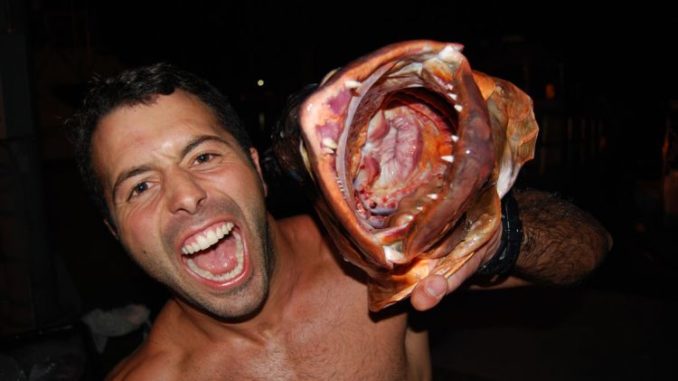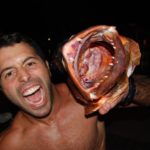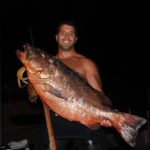
Louisiana’s coast delivers IGFA world record
Some people call them “menacing.”
But pound for pound, cubera snappers probably are no meaner than red snappers, themselves well-known bullies.
Oh, but those teeth.
Cubera snappers are not common here — in fact, they are not common anywhere in their range, which runs from the U.S. South Atlantic, through the Gulf of Mexico, all the Caribbean islands and down South America into Brazil.
They do appear to be less common on the Louisiana coast than elsewhere, but what we lack in numbers, we make up for in size. The IGFA world record of 124 pounds, 12 ounces was caught here.
ID tips: Cubera vs. mangrove
Cubera snappers under 20 pounds can easily be confused with mangrove (gray) snappers, carrying an almost identical body color — gray to reddish-brown. But since the world record mangrove snapper (also caught off Louisiana) is only 18 pounds, 10 ounces, any fish larger than 20 pounds is most likely a cubera.
Cubera snappers also sport eye-poppingly large canine teeth that are visible even with the mouth closed, and they have quite fat lips. A fail-safe method of identification is to open the mouth and run a finger (be brave) over the rough tooth patch located in the roof of the mouth. It is triangular in a mangrove snapper, but anchor-shaped in a cubera snapper.
This brute is named Lutjanus cyanopterus by scientists. Lutjanus comes from “ikan lutjan,” the name of a Malaysian fish in the local official national language Malay. The word cyanopterus means “blue fin” in Latin, even though the fish does not have blue fins.
Snapper facts
Cubera snappers are estimated to live to 22 years and reach spawning maturity in two to four years. Like another offshore giant, the goliath grouper, youngsters live in mangroves, sea grass beds or even freshwater before migrating offshore.
Again like goliath groupers, young cuberas are never found in Louisiana. Apparently for both species, the fish in Louisiana are spillover from prime habitat further south, in South Florida and the Caribbean.
Adults inhabit waters 60 to 250 feet deep and orient around rocky ledges, reefs and ship wrecks. Off of Louisiana, catching one is a chance proposition. But fishermen out of Key Largo, Florida target them.
Prime time for the fishery there is from July though August into mid-September. In July and until early August, when the commercial spiny lobster season opens, most anglers use live blue crabs for bait.
When lobster season opens, they shift to them. It seems that Cubera snappers find the pricey crustaceans as irresistible as do humans. Fish such as goggle-eyes (bigeye scad) and blue runners are also used as bait, but are shark, king mackerel ––and barracuda magnets.
Rigging up to battle cuberas
Heavy tackle, 150-pound test leaders, 10/0 hooks and 24-ounce sinkers are the order of the day for these hard-fighting monsters. The concentration of cuberas off of Key Largo during this period is related to those waters being a known spawning aggregation site for the species.
Some snapper species spawn close to their home reefs. Others, including the cubera, travel long distances to spawn in large groups — up to as many as 10,000 cuberas at a time — using the same spots year after year.
Only two spawning aggregations are known in U.S. waters: the Key Largo location and one off of the Dry Tortugas Islands off the southern tip of Florida. Most are located in more tropical waters.
Belize spawning site
Scientists studied one such location at Gladden Spit on the Belize Barrier Reef for six years. The spot the snappers used again and again was a point on a 75-foot deep reef, right where it broke off into deeper water.
The research divers observed over 100 spawning events during the March to October period, with a peak in activity in May. By day, most cuberas appeared gray underwater because the water filtered out red coloration.
As evening approached, about 80 percent of the fish took on a dark, midnight gray coloration. Those fish, which ranged from 20 to 32 inches long, were males.
Another 5 percent of the fish turned nearly white. These fish, which were females, ranged from 32 to 52 inches long and were plumper than the dark fish.
The remaining 15 percent of the fish stayed silver-gray, their daytime color.
Beginning an hour before sunset, a school of several thousand fish swam back and forth off the edge of the drop-off, very near the bottom in 90 to 120 feet of water. Small groups of fish would leave the main group and swim to within 40 feet of the surface, then dive back down to the main group without spawning.
Twenty minutes later, the main body of fish began swimming in a tight circle and began to spiral towards the surface, with three to eight males following each female. Occasionally, a female would suspend herself head-down within the spiral twitching her body for five to 10 seconds before rejoining the rising cone-shaped mass of fish.
When the top of the school reached a depth of 20 feet, groups of 20 or so fish would rush 6 feet up and turn head-down, this time releasing their eggs and sperm. These spawned fish would swim back down the outside edge of the cone to the bottom.
While this spawning dance occurred over and over again, a few stray females followed by males would bolt 6 to 12 feet to one side out of the cone of fish and release their eggs and sperm.
The large number of eggs and sperm released formed a dense, milky-white cloud 40 feet in diameter. Many egg-eaters zeroed in on the cloud to feed, including yellowtail snappers, rainbow runners, Atlantic spadefish, and even whale sharks (which are filter feeders).
The scientists estimated that cubera snappers released a half-billion eggs each year at this site.
Moon phase was an important factor. While a few fish spawned as early as one day before the full moon, peak spawning activity occurred from three to eight days after the full moon — and sometimes continued until 12 days after the moon.
Typically spawning went on over a 65-minute period, beginning 40 minutes before sunset. Peak spawning occurred at sunset, regardless of tide phase.
This same site is used by other fish species that form spawning aggregations, including groupers, jacks and other snappers.




